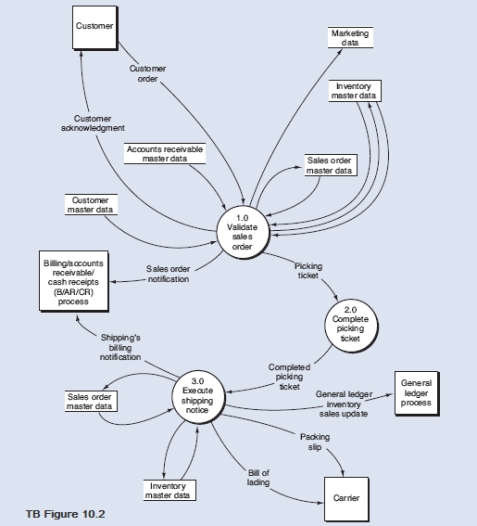Below is a narrative of the "Validate sales order" portion of the order entry/sales process.Narrative Description
How does the OE/S process then validate a customer order? First, process 1.1 verifies the availability of the requested inventory by consulting the inventory master data.If a sufficient level of inventory is on hand to satisfy the request, the order is forwarded for further processing, as depicted by the data flow "Inventory available order." Conversely, if a customer orders goods that are not in stock, process
1.1 runs a special back order routine.This routine determines the inventory requirement necessary to satisfy the order and then sends the back order request to the purchasing department.This activity is depicted by the "Back order" data flow, which in reality is a specific type of exception routine (i.e., a specific type of reject stub).After the goods are received, the order is routinely processed.If the customer refuses to accept a back order, then the sales event is terminated, and the order is rejected, as shown by the "Reject" data flow.Information from the order that has potential value to
marketing is recorded in the marketing data store.After assuring inventory availability, process 1.2 establishes the customer's existence and then evaluates credit.With an enterprise system, one record should exist for each customer, wherever the customer is located and from whatever parts of the organization the customer makes purchases.This allows an organization to readily determine the amount of credit available to that customer worldwide.The credit check adds the amount of the order to accounts receivable balances, open sales orders (i.e., orders about to be receivables), and compare that total to the credit limit.If the customer has exceeded their credit limit, the order is rejected.Upon a successful credit approval, process 1.3 performs the following activities simultaneously:
-Updates the inventory master data to allocate the quantity ordered to the sales
order.The inventory balance could actually be reduced at this time to save a later
update of the inventory master data.-Updates the sales order master data to indicate that a completed sales order has
been created.-Disseminates the sales order.Required: From the DFD in TB Figure 10.2 and the narrative description above, explode bubble 1.0 into a lower-level diagram showing the details of that process. 
Definitions:
Dissociative Theory
Explains certain behaviors and experiences, such as amnesia or identity fragmentation, as a result from a disconnection between thoughts, identity, consciousness, and memory.
Central Nervous System
Comprises the brain and spinal cord, responsible for processing information and controlling bodily functions.
Sedative
A class of drugs that slows brain activity, inducing relaxation or sleep.
Alpha and Theta Waves
Types of brain waves detected by EEG that are associated with different states of brain activity; alpha waves are linked to relaxed, wakeful states, while theta waves are often observed during light sleep and deep meditation.
Q8: To initiate an adjustment for returned goods
Q11: _ provides guidance on how an organization's
Q23: _ are devices that use light reflection
Q34: Which of the following business scandals involved
Q58: A warehouse clerk manually completing an order
Q62: When the sales order department acknowledges a
Q92: Relational integrity specifies that for every attribute
Q101: _ contains a record of each item
Q141: This component of the ERM framework concerns
Q153: The ERM framework is comprised of eight